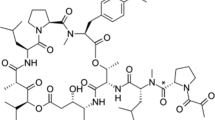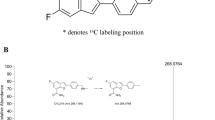Abstract
Dicycloplatin, as a new antitumor supramolecule, was considered to have higher solubility and higher stability compared with carboplatin. The aim of the present study was to evaluate the pharmacokinetic characteristics of platinum originating from dicycloplatin. A rapid, sensitive, and specific method with inductively coupled plasma mass spectrometry (ICP-MS) has been developed for the determination of platinum in bio-samples. The study was performed in male rats and dogs at a single dose of 10 and 5 mg kg−1 separately by intravenous injection. Pharmacokinetic parameters were calculated by non-compartmental method, and the dose of platinum was used in the calculation of these parameters. Results showed that plasma concentrations of platinum began to decrease rapidly initially but decline slowly with a long terminal phase. The mean half-life was 27.39 and 100.98 and clearance was 0.77 and 0.08 L/h/kg for rats and dogs separately. Tissue distribution showed that platinum originating from dicycloplatin had a certain distribution in testis and prostate. Plasma protein binding proportion of platinum was increased with time. In conclusion, this research investigated the pharmacokinetic characteristics including plasma kinetics, tissue distribution, and plasma protein binding of platinum originating from dicycloplatin in rats and dogs in detail for the first time by ICP-MS.





Similar content being viewed by others
References
Rybak LP, Mukherjea D, Jajoo S, Ramkumar V (2009) Cisplatin ototoxicity and protection: clinical and experimental studies. Tohoku J Exp Med 219:177–186
Ji S, Chueh HW, Kim JY, Lim SJ, Cho EJ, Lee SH, Yoo KH, Sung KW, Koo HH (2011) Responses and adverse effects of carboplatin-based chemotherapy for pediatric intracranial germ cell tumors. Korean J Pediatr 54:128–132
Alberts DS, Dorr RT (1998) New perspectives on an old friend: optimizing carboplatin for the treatment of solid tumors. Oncologist 3:15–34
Goto Y, Sekine I, Tanioka M, Shibata T, Tanai C, Asahina H, Nokihara H, Yamamoto N, Kunitoh H, Ohe Y, Kikkawa H, Ohki E, Tamura T (2011) Figitumumab combined with carboplatin and paclitaxel in treatment-naïve Japanese patients with advanced non-small cell lung cancer. Invest New Drugs. doi:10.1007/s10637-011-9715-4
Yang X, Jin X, Song Q, Tang K, Yang Z, Zhang X, Tang Y (2010) Structural studies of dicycloplatin, an antitumor supramolecule. Sci China Chem 53:1346–1351
Peng J, Wu H, Guan Z (2009) Chemotherapy-naive patients with advanced non-small-cell lung cancer-single institution experience. Chin J Clin Oncol 3:711–714
Wang C, Yan R (2005) Assay of the lung cancer cell apoptosis induced by dicycloplatin. J Practical Oncol 19:21–22
Yan D, Tu L, Peng X, Li W, Shen Z (2007) In vitro and in vivo antitumour activity of dicycloplatin, a new active platinum complex. Chin JMAP 24:352–356
Cao B, Chen X, Gu X, Wang G (2003) Pharmacokinetics of 0325k1-1 in dogs. J China Pharm Univ 34:369–371
Chen X, Liu X, Zhang G, Gu X, Meng H, Xin F, Li N, Wang G, Zhu J (2000) The pharmacokinetics of 0325k1-1 in rats. J China Pharm Univ 31:56–60
Villarino N, Cox S, Yarbrough J, Martín-Jiménez T (2010) Determination of carboplatin in canine plasma by high-performance liquid chromatography. Biomed Chromatogr 24:908–913
Warren K, Gervais A, Aikin A, Egorin M, Balis FM (2004) Pharmacokinetics of carboplatin administered with lobradimil to pediatric patients with brain tumors. Cancer Chemother Pharmacol 54:206–212
Delord JP, Umlil A, Guimbaud R, Grégoire N, Lafont T, Canal P, Bugat R, Chatelut E (2003) Population pharmacokinetics of oxaliplatin. Cancer Chemother Pharmacol 51:127–131
Sova P, Mistr A, Kroutil A, Semerád M, Chlubnová H, Hrusková V, Chládková J, Chládek J (2011) A comparative study of pharmacokinetics, urinary excretion and tissue distribution of platinum in rats following a single-dose oral administration of two platinum(IV) complexes LA-12 (OC-6-43)-bis(acetato)(1-adamantylamine)amminedichloroplatinum(IV) and satraplatin (OC-6-43)-bis (acetato) amminedichloro(cyclohexylamine)platinum(IV). Cancer Chemother Pharmacol 67:1247–1256
Jacobs SS, Fox E, Dennie C, Morgan LB, McCully CL, Balis FM (2005) Plasma and cerebrospinal fluid pharmacokinetics of intravenous oxaliplatin, cisplatin, and carboplatin in nonhuman primates. Clin Cancer Res 11:1669–1674
da Costa AC, Jr VMA, Luna AS, de Campos RC (2010) Determination of platinum originated from antitumoral drugs in human urine by atomic absorption spectrometric methods. Talanta 82:1647–1653
Stürup S (2004) The use of ICPMS for stable isotope tracer studies in humans: a review. Anal Bioanal Chem 378:273–282
Morrison JG, White P, McDougall S, Firth JW, Woolfrey SG, Graham MA, Greenslade D (2000) Validation of a highly sensitive ICP-MS method for the determination of platinum in biofluids: application to clinical pharmacokinetic studies with oxaliplatin. J Pharm Biomed Anal 24:1–10
Breda M, Maffini M, Mangia A, Mucchino C, Musci M (2008) Development and validation of an inductively coupled plasma mass spectrometry method with optimized microwave-assisted sample digestion for the determination of platinum at ultratrace levels in plasma and ultrafiltrate plasma. J Pharm Biomed Anal 48:435–439
Liu QF, Li X, Su Q, Luo GA, Wang YM, Liu WP (2009) Investigation on pharmacokinetics, tissue distribution and excretion of a novel anticancer platinum compound by inductively coupled plasma mass spectrometry after intravenous administration to rats. Arch Pharm Res 32:1621–1628
Brouwers EE, Tibben MM, Rosing H, Hillebrand MJ, Joerger M, Schellens JH, Beijnen JH (2006) Sensitive inductively coupled plasma mass spectrometry assay for the determination of platinum originating from cisplatin, carboplatin, and oxaliplatin in human plasma ultrafiltrate. J Mass Spectrom 41:1186–1194
Clerico A, Cappelli C, Ragni G, Caroli S, De Ioris MA, Sordi A, Petrucci F, Bocca B, Alimonti A (2006) Evaluation of carboplatin pharmacokinetics in pediatric oncology by means of inductively coupled plasma mass spectrometry. Ann Ist super Sanita 42:461–468
Spezia S, Bocca B, Forte G, Gatti A, Mincione G, Ronchi A, Bavazzano P, Alimonti A, Minoia C (2005) Comparison of inductively coupled plasma mass spectrometry techniques in the determination of platinum in urine: quadrupole vs. sector field. Rapid Commun Mass Spectrom 19:1551–1556
Ghezzi A, Aceto M, Cassino C, Gabano E, Osella D (2004) Uptake of antitumor platinum(II)-complexes by cancer cells, assayed by inductively coupled plasma mass spectrometry (ICP-MS). J Inorq Biochem 98:73–78
Siddik ZH, Newell DR, Boxall FE, Harrap KR (1987) The comparative pharmacokinetics of carboplatin and cisplatin in mice and rats. Biochem Pharmacol 36:1925–1932
Newell DR, Siddik ZH, Gumbrell LA, Boxall FE, Gore ME, Smith IE, Calvert AH (1987) Plasma free platinum pharmacokinetics in patients treated with high dose carboplatin. Eur J Cancer Clin Oncol 23:1399–1405
Qin Z, Caruso JA, Lai B, Matusch A, Becker JS (2011) Trace metal imaging with high spatial resolution: applications in biomedicine. Metallomics 3:28–37
Su L, Mruk DD, Lee WM, Cheng CY (2011) Drug transporters and blood–testis barrier function. J Endocrinol 209:337–351
Liebner S, Czupalla CJ, Wolburg H (2011) Current concepts of blood–brain barrier development. Int J Dev Biol 55:467–476
Sterbis JR, Rice KR, Javitt MC, Schenkman NS, Brassell SA (2010) Fusion imaging: a novel staging modality in testis cancer. J Cancer 1:223–229
Schwaab T, Pili R (2011) Provenge: combating prostate cancer with a vengeance? Expert Rev Vaccines 10:1113–1114
Acknowledgments
This work was supported by Jiangsu province Nanjing City Innovative Graduate Research Program (No.CXZZ11_0828).
Author information
Authors and Affiliations
Corresponding author
Rights and permissions
About this article
Cite this article
Zhao, D., Zhang, Y., Xu, C. et al. Pharmacokinetics, Tissue Distribution, and Plasma Protein Binding Study of Platinum Originating from Dicycloplatin, a Novel Antitumor Supramolecule, in Rats and Dogs by ICP-MS. Biol Trace Elem Res 148, 203–208 (2012). https://doi.org/10.1007/s12011-012-9364-2
Received:
Accepted:
Published:
Issue Date:
DOI: https://doi.org/10.1007/s12011-012-9364-2




